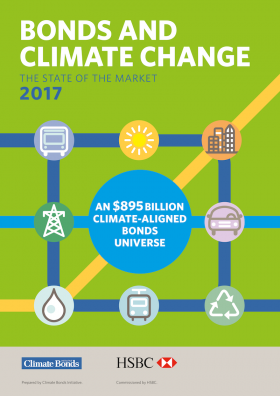The ‘Bonds and Climate Change: State of the Market 2017’ report is an in-depth analysis of the climate-aligned and labelled green bond markets.
The Report quantifies all bonds where proceeds are being used to finance low carbon and climate resilient infrastructure.
In this report, we uncover bonds that finance investments compatible with a 2-degree transition path rather than investments that are marginally environmentally beneficial.
This takes a cue from the Paris COP21 Agreement that investments should be in line with the steep emission reduction trajectory needed to achieve a rapid transition to a sub-2-degree Celsius world.
The 2017 report also has a focus on cities, with case studies identifying best practice and opportunities for green city bonds.
Headline Figures
This year’s analysis estimates that climate-aligned bonds universe now stands at $895bn outstanding - A jump of $201bn from the 2016 figure. This total is comprised of unlabelled climate-aligned bonds at $674bn and labelled green bonds at $221bn.
- The $201bn increase on 2016 includes $138bn in new bonds from existing issuers, plus 144bn from new issuers minus $81bn of matured bonds and issuers that no longer meet our climate-aligned criteria.
- In the climate-aligned bond universe, the Chinese RMB is the dominant currency (with 32% of the total amount outstanding), followed by the US dollar (26%) and the Euro (20%).
- Low Carbon Transport was the largest single sector, accounting for $544bn (61%) of the total $895bn climate aligned universe, followed by clean energy at $173.4bn (19%).
- Building and Industry, Agriculture and Forestry, Waste and Pollution, Water comprise 7% and Multi-Sector bonds are at 13% up from the 2016 figure of 8.2%, a small but welcome pointer towards more diversity in issuance.
The dataset of this year’s report is comprised of a universe of $895bn climate-aligned bonds outstanding, made up of 3,493 bonds from 1,128 issuers across seven climate themes: transport, energy, multi-sector, water, buildings and industry, waste and pollution, agriculture and forestry.
This year’s dataset includes all Climate-Aligned and Green Bonds issued after 1st January 2005 and before 30th June 2017.
Green Bonds Summary
- The largest labelled green bond issuers in descending order are Supranationals, USA, China, France, Germany, Netherlands, Sweden, Spain, Canada, Australia, India and Brazil.
- Globally, development banks are the largest green issuers with EIB, KfW and World Bank in the top three positions.
- Issuance from corporates and commercial banks has grown, but demand from institutional investors continues to outstrip supply.
- There is significant headroom for more quality green issuance, particularly from banks and corporates. Increasing bank based and corporate issuance is now a vital component in meeting climate finance targets & country climate plans.
- Accelerating green finance to reach $1trillion in green bonds by 2020 is a Climate Bonds objective. See more on P20.
Download the report here.
Visuals (graphs and pie charts for download)
- Green Bonds Use of Proceeds
- Green Bonds Currency Issuance
- Top 12 Largest Green Bonds Issuers
- Type of Green Bonds Issuers
The State of the Market Report is commissioned by HSBC and is produced on an annual basis by the Climate Bonds Initiative. This is the 6th annual report, and can be downloaded here. Previous reports can be found here.
